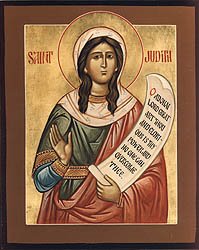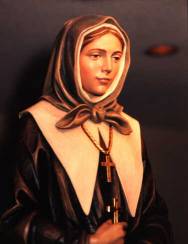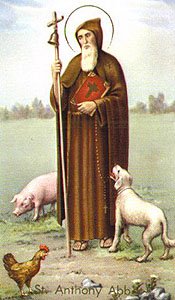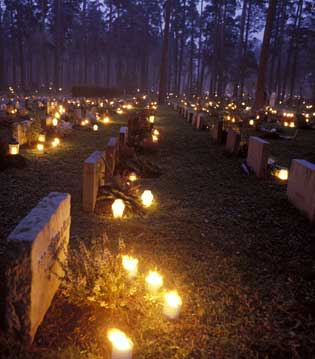 Agatha was very beautiful and lived in Sicily in the third century. The governor heard how beautiful she was and brought her to his palace. He wanted to make her commit sins, but she was brave and would not give in.
Agatha was very beautiful and lived in Sicily in the third century. The governor heard how beautiful she was and brought her to his palace. He wanted to make her commit sins, but she was brave and would not give in.
She prayed, "My Lord Jesus Christ, you see my heart and you know my desire. I am all yours. Save me from this evil man. Make me worthy of winning out over the devil."
The governor then sent Agatha to the house of a wicked woman and hoped she would become bad too. Agatha had great trust in God and prayed all the time. She kept herself pure. She would not listen to the evil ideas of the woman and her daughters. After a month, she was brought back to the governor. He tried again to win her. "You are a noblewoman," he said kindly. "Why have you lowered yourself to be a humble Christian?"
"Even though I am a noble," answered Agatha, "I am a slave of Jesus Christ." "Then what does it really mean to be noble?" the governor asked. Agatha answered, "It means to serve God."
When he realized that she would not sin, the governor became angry. He had Agatha whipped and tortured.
Agatha soon died a martyr at Catania, Sicily, in the year 250.
 Martha was the sister of Mary and Lazarus who lived in the little town of Bethany near Jerusalem. They were dear friends of Jesus, and he often visited them. In the Gospel of St. John we see: "Jesus loved Martha, and her sister Mary and Lazarus."
Martha was the sister of Mary and Lazarus who lived in the little town of Bethany near Jerusalem. They were dear friends of Jesus, and he often visited them. In the Gospel of St. John we see: "Jesus loved Martha, and her sister Mary and Lazarus."
It was St. Martha who lovingly served the Lord when he visited them. One day, she was preparing a meal for Jesus and his disciples. She realized that the task would be easier if her sister Mary would help instead of sitting quietly at Jesus' feet, listening to him. "Lord, tell my sister to help me," Martha suggested. Jesus was very pleased with Martha's loving service but he wanted her to know that listening to God's Word and praying is even more important. So he said gently, "Martha, Martha, you are anxious about many things, but only one thing is necessary. Mary has chosen the better part." St. Martha's great faith in Jesus was seen when her brother Lazarus died. As soon as she heard that Jesus was coming to Bethany, Martha went to meet him. She trusted Jesus and said to him: "Lord, if you had been here, my brother would not have died." Jesus told her that Lazarus would rise. He said, "He who believes in me, even if he dies, shall live. Do you believe this?" Martha answered, "Yes, Lord, I believe that you are the Christ, the Son of God, who has come into the world." Jesus worked a great miracle and raised Lazarus from the dead!
Later, Jesus came again to have supper with Lazarus, Martha and Mary. St. Martha served them at table as always. This time, though, Martha did it lovingly and served them with a joyful heart.
 Bridget was born in Uppsala, Sweden. Her mother Ingeborg was a holy woman and her father Birger Persson, who had royal ancestors, was a rich landowner. He was also the governor and provincial judge of Uppland. From the time she was a child, Bridget received visions of Jesus.
Bridget was born in Uppsala, Sweden. Her mother Ingeborg was a holy woman and her father Birger Persson, who had royal ancestors, was a rich landowner. He was also the governor and provincial judge of Uppland. From the time she was a child, Bridget received visions of Jesus.
When she was only ten, she saw Jesus on the cross and hear him say, "Look at me, my daughter." "Who has treated you like this?" cried little Bridget. "They who despise me and refuse my love for them," answered Jesus. From then on, Bridget tried to stop people from offending Jesus. Her mother died when she was twelve and she was brought up by her good aunt. When she was fourteen, she married eighteen-year-old prince Ulf of Nercia. Like Bridget, Ulf had set his heart on serving God. They had eight children, of whom one was St. Catherine of Sweden.
Bridget and Ulf served the Swedish court. Bridget was the chief lady-in-waiting to Queen Blanche of Namur and she tried to help and guide King Magnus and the queen lead better lives. All her life, Bridget had visions and received special messages from God. She obeyed God's commands and visited many rulers, two popes, priests and other important people in the Church, humbly explaining what God wanted them to do. After her husband died, Bridget put away her rich clothes and lived as a poor nun. This did not please the people at the king's court. Later, she started the order of the Most Holy Savior, also known as Bridgettines. She still kept up her own busy life, traveling about doing good everywhere. And Jesus continued to reveal many secrets to her which she received with all humility. Before she died, Bridget went on a pilgrimage to the Holy Land. At the shrines there, she had visions of what Jesus had said and done in that place. She encouraged all who would listen to meditate on the Passion of Jesus Crucified. All St. Bridget's revelations on the sufferings of Jesus were published after her death.
 Judith was born in Thuringia which is now central Germany. Her family was rich but she wanted to follow the example of St. Elizabeth of Hungary. In Judith's time, many Christian women were influenced by her inspiring example.
Judith was born in Thuringia which is now central Germany. Her family was rich but she wanted to follow the example of St. Elizabeth of Hungary. In Judith's time, many Christian women were influenced by her inspiring example.
When she was fifteen, Judith was married to a wealthy young nobleman. She tried to be a good Christian wife and was very generous with the poor. Her husband was a good man, but he was happy with his rich and comfortable life.
He also wanted his wife to dress and live like a rich woman so that people would respect them. Judith gently made him realize that they would have more to give to people less fortunate than themselves if they lived and dressed more simply.
Judith's husband died suddenly while he was on a pilgrimage to the Holy Land. As a young widow Judith raised her children alone. When the children grew up, Judith finally gave in to a longing that had been hidden in her heart even during the busy, happy days of her life.
She sold everything she had and moved to Prussia where people would not know that she was from a wealthy family. There she lived as a hermit in a little hut and spent her time praying and taking care of weary travelers who passed by.
She prayed especially for nonbelievers to come to Jesus in faith and for the newly baptized Christians to be true to their faith. "Three things can lead us close to God," she once said. "They are painful physical suffering, being in exile in a foreign land, and being poor by choice because of love for God."
St. Judith died of fever in 1260 and was named the patroness of Prussia.
 Anne Marguerite Adelaide Emily de Vialar was born in southern France. She was the only daughter of Baron James Augustine de Vialar and Antoinette. Her wealthy parents sent her to school in Paris but at the age of fifteen, she returned to her small town of Gaillac when her mother died.
Anne Marguerite Adelaide Emily de Vialar was born in southern France. She was the only daughter of Baron James Augustine de Vialar and Antoinette. Her wealthy parents sent her to school in Paris but at the age of fifteen, she returned to her small town of Gaillac when her mother died.
Her father was interested in finding a suitable husband for his daughter. He became very angry when Emily flatly refused to marry because she wanted to be a religious sister and give her life to God.
When Emily was twenty-one, a new priest, Father Mercier, arrived in Gaillac. Emily went to him for direction as she wanted to help the poor and the sick. Father Mercier helped her set up an out-patient service right on the terrace of the de Vialar home.
Emily's father was upset by all the bother and this tense situation between Emily and her father existed for fifteen years. Then Emily's grandfather, the Baron de Portal, died leaving Emily a large fortune. At last she could have the independence she needed to begin her great work for God.
With the help of Father Mercier, Emily bought a large house in her hometown. She and three other women began a religious order. They designed a habit and chose the name “Sisters of St. Joseph of the Apparition”.
The archbishop blessed their congregation and ministry. These sisters would be care for the sick and poor, and educate children. Twelve young women joined the group within three months. Sister Emily pronounced her vows in 1835 along with seventeen other sisters.
The Sisters of St. Joseph started branch convents. In 1847, the sisters went to Burma and in 1854, to Australia. In forty years, Mother Emily saw her congregation grow from the patio of her home to some forty convents around the world.
Mother Emily wrote many letters which showed her great love for God, for his Church and for people. She saw in her heart people everywhere who needed the truth of the Gospel and the love that Christ brings.
Mother Emily died on August 24, 1856.
 Marguerite was born in France, and was the sixth of twelve children. Her parents were devout people and lived holy lives. When Marguerite was nineteen, her mother died. She took care of her younger brothers and sisters. Her father then died when she was twenty-seven.
Marguerite was born in France, and was the sixth of twelve children. Her parents were devout people and lived holy lives. When Marguerite was nineteen, her mother died. She took care of her younger brothers and sisters. Her father then died when she was twenty-seven.
When the family was raised, Marguerite prayed to know what to do with her life. The governor of Montreal, Canada, was visiting France. He was looking for teachers and he invited Marguerite to come to Montreal to teach school and religion classes. She said yes.
Marguerite gave away all her belongings to other members of the family. They couldn't believe that she would really leave their civilized country to go to a wild new country across the ocean.
She set sail on June 20, 1653, and arrived in Canada in mid-November. Marguerite began the construction of a chapel in honor Our Lady of Good Help in 1657. Then in 1658, she opened her first school.
Marguerite needed the help of more teachers. She returned to France in 1659 and returned with four companions. In 1670, she returned to France again and brought back six companions. These brave women became the first sisters of the Congregation of Notre Dame.
St. Marguerite and her sisters helped people in the colony survive when food was scarce. They opened a vocational school and taught young people how to run a home and farm.
St. Marguerite's congregation was growing. By 1681 there were eighteen sisters. Seven were Canadian. They opened more missions and two sisters taught at the Indian mission. Marguerite herself received the first two Indian women into the congregation.
When Mother Marguerite was seventy three years old, she handed over her congregation to the new superior Marie Barbier, who the first Canadian to join the order. St. Marguerite's religious rule was approved by the Church in 1698.
Marguerite spent her last few years praying and writing an autobiography. On December 31, 1699, a young sister lay dying. Mother Marguerite asked the Lord to take her life in exchange.
By the morning of January 1, 1700, the sister was completely well and Mother Marguerite had a very high fever. She suffered for twelve days and died on January 12, 1700.
 Anthony was born in Egypt. When he was twenty years old, his parents died. They left him a large estate and placed him in charge of the care of his young sister. Anthony felt overwhelmed and turned to God in prayer.
Anthony was born in Egypt. When he was twenty years old, his parents died. They left him a large estate and placed him in charge of the care of his young sister. Anthony felt overwhelmed and turned to God in prayer.
He soon became more and more aware of the power of God in his life. About six months later, he heard this quotation of Jesus from the Gospel: "Go, sell what you own and give the money to the poor, and you will have treasure in heaven" (Mark 10:21).
He took the words as a personal message in answer to his prayer for guidance. He made sure that his sister completed her education, then sold his house, furniture, and the land he owned and gave the money to the poor and to the people who needed it. Anthony's sister joined a group of women living a life of prayer and contemplation. Anthony decided to become a hermit. Then at the age of thirty-five he moved alone to the desert, living in an abandoned fort and began his own life of prayer and penance alone with God.
He devoted himself to prayer and penance. For more than twenty years Anthony was tempted by the devil, but he overcame temptation by prayer and sacrifice.
By the time he was fifty-five, people found out where he was and began coming to him for healing and for spiritual counseling. Finally, Anthony built two monasteries on the Nile, one at Pispir and one at Arsinoe. The monks and people who lived around him supported themselves by making and selling baskets and brushes. Many people heard of him and came to him looking for advice. He would give them practical advice such as: "The devil is afraid of us when we pray and make sacrifices. He is also afraid when we are humble and good. He is especially afraid when we love Jesus very much. He runs away when we make the Sign of the Cross."
He consented to guide them in holiness. He started the first monastery, so people call him the father of monastic life and the patriarch of monks. His miracles drew so many people so he left and went into the desert again, where he lived by hard work and prayer.
Anthony died at the age of 105 after a long, prayerful life in 356.
 November 2 This feast day is one of the most loving celebrations in the Church's liturgy. It is the day that we especially remember all those who have passed from this life into the next. Today we stop to remember all who have died especially our relatives and friends. We pray for those who taught us good things and made sacrifices for us. We pray for those who prayed for us while they were on this earth. We pray for the most forgotten souls. We pray for those who had great responsibilities while they were on earth. We remember the holy souls in purgatory and we realize that they are saved and will go to heaven. Now they wait, being purified, until the moment when they can be with God, face to face. We can offer the sacrifice of the Mass and pray for the suffering souls in purgatory to hasten their journey to God. Eternal Rest
November 2 This feast day is one of the most loving celebrations in the Church's liturgy. It is the day that we especially remember all those who have passed from this life into the next. Today we stop to remember all who have died especially our relatives and friends. We pray for those who taught us good things and made sacrifices for us. We pray for those who prayed for us while they were on this earth. We pray for the most forgotten souls. We pray for those who had great responsibilities while they were on earth. We remember the holy souls in purgatory and we realize that they are saved and will go to heaven. Now they wait, being purified, until the moment when they can be with God, face to face. We can offer the sacrifice of the Mass and pray for the suffering souls in purgatory to hasten their journey to God. Eternal Rest
Eternal rest grant unto them, O Lord,and let perpetual light shine upon them.May they rest in peace. Amen.








